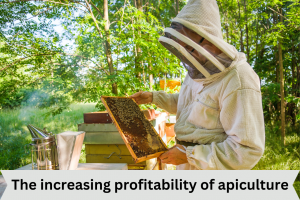ForumIAS announcing GS Foundation Program for UPSC CSE 2025-26 from 19 April. Click Here for more information.
Source: The post Beekeeping in India has been created, based on the article “The increasing profitability of apiculture” published in “Business standard” on 15th April 2024.
UPSC Syllabus Topic: GS Paper 3-economy-agriculture
News: This article discusses the growth and potential of India’s beekeeping industry, highlighting its significance in agriculture and exports. The increasing profitability of apiculture
For details information on Apiculture- Scope and Opportunities read here
What is the current state of beekeeping in India?
1.India is the sixth-largest global exporter of honey.
2.Since 2005-06, honey production in India has increased by 240%, and exports have grown by 260%.
3.From 2018-19 to 2022-23, domestic production rose by 72% (from 77,000 tonnes to 133,000 tonnes), and exports increased by 86% (from 43,000 tonnes to about 80,000 tonnes).
4.Currently, about 80% of India’s honey exports go to the United States, with smaller quantities shipped to the UAE, Saudi Arabia, Libya, Morocco, and Canada.
5.Beekeeping is primarily practiced in Uttar Pradesh, West Bengal, Punjab, Bihar, and Maharashtra.
What are the benefits of beekeeping?
Economic Growth: Beekeeping significantly contributes to agriculture and exports, with Indian honey exports growing faster than production rates, showcasing its profitability.
Health Benefits: Honey is recognized for its health-enhancing properties, including boosting immunity and having antibacterial effects, which became particularly valued during the pandemic.
Agricultural Benefits: Honeybees are crucial for pollinating approximately 16% of the world’s important flowering plant species, enhancing crop yields and quality significantly. For instance, honeybee pollination can increase seed production of radish by 22-100% and of cabbage and cucumber by up to 400%.
Pharmaceutical and Cosmetic Industry Demand: By-products like royal jelly, bee wax, and propolis are in high demand due to their beneficial properties, supporting various industries.
What Challenges Does the Indian Honey Sector Face?
Market Diversification: Currently, nearly 80% of Indian honey exports are to the United States, indicating a heavy reliance on a single market.
Quality Issues: There is rampant adulteration of honey with sugar syrup, which negatively affects the reputation of Indian honey both domestically and internationally.
Geographic Limitation: Beekeeping is confined primarily to certain states (Uttar Pradesh, West Bengal, Punjab, Bihar, and Maharashtra), limiting national production capacity.
What Government Initiatives Support Beekeeping?
National Beekeeping and Honey Mission: This initiative was launched to accelerate the technological modernization of the beekeeping sector and improve productivity.
National Bee Board: Part of broader efforts to support the honey industry, this board plays a role in technological advancements and sector growth.
“Sweet Revolution”: Introduced in 2017 to expand and enhance the honey sector along the lines of the Green and White Revolutions.
ICAR’s Research Projects: The Indian Council of Agricultural Research conducts an all-India coordinated research project on honeybees and pollinators to boost honey output and overall quality through specific regional strategies.
Question for practice:
Evaluate the growth and potential of India’s beekeeping industry, considering its current state, benefits, challenges, and government initiatives.





